饺子机及输送成型部件设计
智能饺子机器人的设计与制造技术

智能饺子机器人的设计与制造技术饺子是中国传统的美食之一,凝聚了中华文化的魅力。
然而,手工制作饺子费时费力,对于现代快节奏的生活方式来说并不实际。
因此,饺子机器人的问世,为人们提供了便捷的饺子制作方式,这种智能设备在制作饺子方面的作用越来越重要。
本文将介绍智能饺子机器人的设计与制造技术。
一、设计原理饺子机器人的设计原理主要分为三个部分:饺子皮、馅料和成型。
具体来说,饺子皮由面团制成,馅料由不同的肉类和蔬菜混合而成,成型则由机器人自行完成。
通常情况下,饺子机器人会根据需要自动计算出饺子皮和馅料的比例,混合和搅拌馅料,最后将饺子皮和馅料包裹在一起完成成型。
二、关键技术智能饺子机器人要实现准确、高效的成型,主要需掌握以下关键技术:1. 饺子皮的制作饺子皮的制作是饺子机器人成型的前提。
面团要按比例混合好面粉、水和其他配料,然后使用饺子机器人提供的面团成型机,将面团压成饺子皮。
使用面团成型机制作出来的饺子皮有着更加均匀、一致的厚度和形状。
2. 馅料制作馅料的质量直接影响着饺子的味道和口感,因此制作馅料要格外注意。
馅料的配方和口味可以根据不同的消费群体和地区变化而调整。
在整个制作过程中,我们需要注意馅料的混合比例、配料的新鲜度和处理方法等细节。
3. 成型技术饺子机器人成型技术的设计是基于机器视觉和机械臂控制,通过摄像头可以识别饺子皮的大小和形状,通过机械臂控制饺子馅的均匀分布,最终形成好看、美味的饺子。
三、未来发展随着人们饮食习惯的变化,饺子机器人已经成为其生活中必不可少的智能设备之一。
未来,随着科技的不断创新,饺子机器人领域的技术将不断提高和改善。
例如,在成型方面,机器人将具备更高的智能和精度,可以根据客户的口味和需求定制成型流程。
此外,发展更多小型化的饺子机器人也是一个趋势,使得普通家庭也可以轻松制作饺子。
此外,将生鲜食材与机器人设备融合,可以实现更加便捷、高效的饺子制作。
总之,智能饺子机器人的发明改变了饺子制作的传统方式,为我们提供了快速、便捷、实用的饺子制作方法。
简单包饺子机构简图

包馅成型机械结构
概述
• 食品中含馅食品所占比例相当大,如包子、饺子、汤圆、 馄饨等。随食品工业的迅速发展,一些专用的包馅成型机 逐渐替代了传统的手工制作。含馅食品的结构形式及种类
多且复杂,目前绝大多数的包馅食品均有各自专用的包馅
成型机。
• 生产带馅食品的设备称为夹馅机。
• 夹馅食品一般由外皮与内馅组成。
9-垂直面坏供送螺旋
10-中间输馅管 11-皮料转嘴 12-右成型盘 13-包馅食品 14-输送带 15-回转托盘 16-正在切割 17-左成型盘
图8-19 包馅机成型原理
• 如图8-19所示。 • 面料→双输面绞龙2→切刀3→面坯压辊4→竖纹龙9的螺旋空
间→面馅复合转嘴11→面料被挤压成筒状面管。
馅料则在被推出水平进给绞龙之后,进入叶片泵,由旋转
叶片使馅料转向90°,并沿输馅管向下移动,在输送过程 中馅料内的空气被排出,馅料被压实成为棒状,这样避免 了供馅不准的现象,有利于准确定量。
1-面坯料斗 2-水平面坯供送螺旋 3-切刀
4-面坯压辊 5-馅料斗
6-水平馅料供送螺旋 7-馅料压辊 8-馅料供送叶片泵
的产品个数越多。
图8-21 球状成型盘作业过程
(a)开始接料 (b)开始成型 (c)、(d)滚球切割 (e)切割结束 (f)成型结束
(五)夹 馅机传 动系统
• 夹馅机是面类食品加工机械中较为复杂的一种设备,其传动 系统如上图所示。
• 该机的动力由电动机1经一级三角皮带减速,带动轴I回转。
轴I将动力分两路传递给夹馅机的各个执行机构。 • 传动路线如下图所示。
• 输馅部分:馅斗、两只水平输馅绞龙及叶片泵。
• 撒粉装置:面粉斗、粉刷、粉针及布粉盘组成。 • 成型装置:两只回转成型盘、托盘及复合嘴。 • 传动系统:一台2.2kw的电机、皮带无级变速器、双蜗轮箱 及各种齿轮变速箱等。 • 如图8-18所示。
年产50000吨水饺生产车间的设计毕业设计
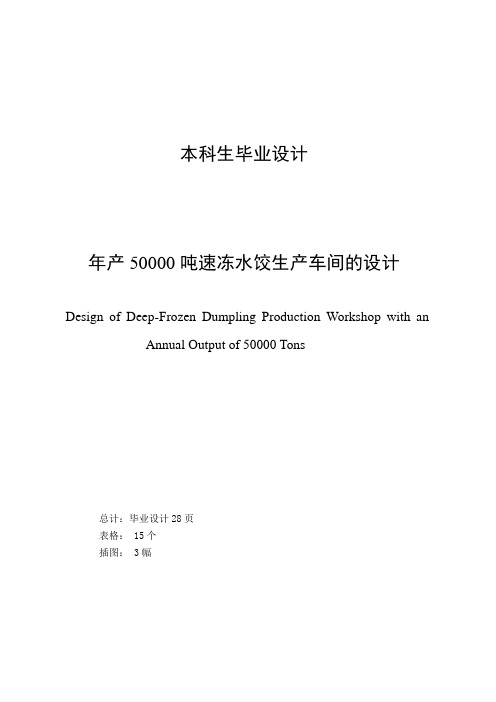
本科生毕业设计年产50000吨速冻水饺生产车间的设计Design of Deep-Frozen Dumpling Production Workshop with an Annual Output of 50000 Tons总计:毕业设计28页表格: 15个插图: 3幅南阳理工学院本科毕业设计年产50000吨速冻水饺生产车间的设计Design of Deep-Frozen Dumpling Production Workshop with an Annual Output of 50000 Tons学院:生物与化学工程学院专业:食品科学与工程学生姓名:宋盼盼南阳理工学院Nanyang Institute of Technology年产50000吨速冻水饺生产车间的设计毕业论文(设计)原创性声明本人所呈交的毕业论文(设计)是我在导师的指导下进行的研究工作及取得的研究成果。
据我所知,除文中已经注明引用的内容外,本论文(设计)不包含其他个人已经发表或撰写过的研究成果。
对本论文(设计)的研究做出重要贡献的个人和集体,均已在文中作了明确说明并表示谢意。
作者签名:日期:毕业论文(设计)授权使用说明本论文(设计)作者完全了解**学院有关保留、使用毕业论文(设计)的规定,学校有权保留论文(设计)并向相关部门送交论文(设计)的电子版和纸质版。
有权将论文(设计)用于非赢利目的的少量复制并允许论文(设计)进入学校图书馆被查阅。
学校可以公布论文(设计)的全部或部分内容。
保密的论文(设计)在解密后适用本规定。
作者签名:指导教师签名:日期:日期:注意事项1.设计(论文)的内容包括:1)封面(按教务处制定的标准封面格式制作)2)原创性声明3)中文摘要(300字左右)、关键词4)外文摘要、关键词5)目次页(附件不统一编入)6)论文主体部分:引言(或绪论)、正文、结论7)参考文献8)致谢9)附录(对论文支持必要时)2.论文字数要求:理工类设计(论文)正文字数不少于1万字(不包括图纸、程序清单等),文科类论文正文字数不少于1.2万字。
水饺加工机设计毕业论文

青岛农业大学毕业论文(设计)题目:水饺加工机设计姓名:学院:机电工程学院专业:农业机械化及其自动化班级:2013 年 06 月 16 日目录摘要 (Ⅰ)Abstract (Ⅱ)1绪论 (1)1.1水饺加工机设计的目的和意义 (1)1.2水饺加工机国内外研究现状 (1)1.3水饺加工机分类............................................................ (3)2设计要紧研究的内容及要求............................................................ . (4)1.3水饺加工机工艺流程............................................................ . (4)1.3水饺加工机设计的技术路线............................................................ . (5)3水饺加工机总体方案的确定 (6)3.1方案的拟定............................................................ .. (6)3.2方案的确定............................................................ .. (9)4成型机构各部件设计 (10)4.1输馅机构的设计 (10)4.2输面机构的设计 (13)4.3成型机构的设计 (15)5水饺加工机传动机构的确定 (19)5.1电动机的选择 (19)5.2传动比设计 (20)5.3带轮的设计 (21)5.4轴的设计 (22)5.5传动结构设计 (23)6结论 (26)6.1结论 (26)6.2设计中的不足 (26)参考文献.....................................................................................................27致谢 (28)水饺加工机设计摘要本文结合了手工水饺制作工艺,借鉴国内已有的水饺加工机,设计了适合国内小作坊生产模式的灌肠式水饺加工机。
饺子机毕业设计

饺子机毕业设计饺子机毕业设计在如今快节奏的生活中,人们对于方便、快捷的食品需求越来越高。
而饺子作为中国传统美食之一,一直以来都受到人们的喜爱。
然而,手工包饺子费时费力,不少人为了省事,选择了速冻饺子。
为了解决这个问题,我决定以饺子机为毕业设计的主题,设计一款能够方便快捷包饺子的机器。
首先,我将从外观设计开始入手。
饺子机的外观设计要简洁大方,符合现代审美。
我计划采用不锈钢材质,外观光滑,易于清洁。
机器的尺寸也要适中,方便携带和存放。
同时,为了增加机器的稳定性和安全性,我会在底部设计防滑垫,确保在操作过程中不会滑动或翻倒。
其次,我将注重饺子机的功能设计。
饺子机应该具备自动搅拌、擀皮和包馅的功能,以减轻用户的操作负担。
在自动搅拌方面,我会采用高速电机,确保面团的均匀搅拌。
在擀皮方面,我会设计一个专门的擀皮装置,能够根据用户的需求调整擀皮的厚度和大小。
在包馅方面,我会设计一个智能感应系统,能够根据馅料的重量和大小自动调整包饺子的速度和力度,确保每个饺子的大小和形状一致。
除了基本功能外,我还计划添加一些创新功能。
例如,我会在饺子机上加装一个电子屏幕,用于显示饺子的制作进程和剩余时间。
同时,我会设计一个智能控制系统,能够根据用户的口味和喜好调整饺子的味道和口感。
用户可以通过触摸屏幕进行设置,选择不同的馅料和调料,机器会根据用户的选择自动调整配方和烹饪时间,制作出符合用户口味的饺子。
在实现这些功能的同时,我也会考虑到机器的安全性和易用性。
例如,我会在机器上加装多重安全保护装置,如过热保护、电流保护等,确保在使用过程中不会发生意外。
同时,我会设计一个简单易懂的操作界面,用户只需按照屏幕上的指示进行操作,即可轻松包出美味的饺子。
最后,我会进行充分的市场调研和用户需求分析,了解消费者对于饺子机的需求和期望。
通过与厨师、家庭主妇等目标用户的交流,我可以更好地了解他们在包饺子过程中遇到的问题和困难,从而针对性地进行设计和改进。
饺子机毕业设计

饺子机毕业设计一、引言随着科技的发展和人类对生活品质追求的提升,家用电器设备在我们的日常生活中扮演着越来越重要的角色。
特别是在厨房中,各种各样的设备在方便我们生活的同时,也让我们对生活充满了期待。
在这其中,饺子机作为一种能够自动化制作饺子的设备,越来越受到人们的喜爱。
本文将介绍一种新型的饺子机毕业设计,该设计在提高饺子制作效率的同时,也保证了饺子的口感和质量。
二、饺子机的设计理念本设计的饺子机主要基于自动化和人性化的设计理念。
所谓自动化,是指饺子机的操作能够完全由机器完成,从饺子的制作到煮熟,用户只需要输入原料和操作指令即可。
所谓人性化,是指机器的设计要符合用户的使用习惯,使操作更加简单方便。
同时,设计也将考虑机器的清洁和维护问题,以方便用户使用。
三、饺子机的结构与功能本设计的饺子机主要包括以下几部分:原料输入部分、搅拌部分、成型部分、煮制部分和控制系统。
1、原料输入部分:用户可以将购买的或者自己准备的饺子原料通过该部分放入机器。
2、搅拌部分:该部分主要负责将原料搅拌均匀,形成饺子馅。
3、成型部分:该部分将通过机械压力和模具,将饺子馅挤压成饺子的形状。
4、煮制部分:通过预设的程序,将成型后的饺子煮熟。
5、控制系统:负责控制整个机器的运行,用户可以通过触控屏或者手机APP进行操作。
四、毕业设计的特点和创新点本设计的饺子机有以下特点和创新点:1、全自动化的操作:从原料的输入到饺子的煮熟,全部都可以通过机器自动化完成,大大提高了饺子的制作效率。
2、人性化的设计:机器的操作界面简单直观,方便用户操作。
同时,机器还配备了多种模具,可以制作不同形状和花样的饺子。
3、健康环保:机器在制作饺子的过程中,不会添加任何人工色素或者防腐剂,保证了饺子的健康环保。
4、保存和再加热功能:机器配备有保存和再加热功能,用户可以将制作好的饺子保存起来,待需要的时候再加热食用。
五、结论本设计的饺子机在自动化、人性化、健康环保以及保存再加热等方面都有很大的创新和优势。
饺子成型机
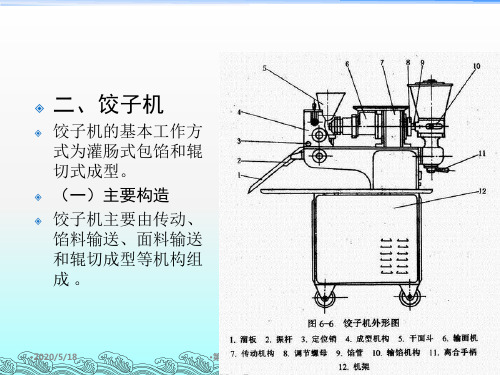
2.面料输送机构
•2013-7-26
•第六章 食品成型机械
ห้องสมุดไป่ตู้
•4
3.饺子成型
饺子机上广泛采用 灌肠辊切成型方式。
•2013-7-26
•第六章 食品成型机械
•5
•2013-7-26
•第六章 食品成型机械
•6
•2013-7-26
•第六章 食品成型机械
•7
(三)饺子机
饺子机是借机械运动 完成饺子包制操作过 程的设备。其基本工 作方式为灌肠式包馅 和辊切式成型。
•2013-7-26
•第六章 食品成型机械
•2
叶片泵的工作原理: 叶片泵是一种容积式泵,具有压力大、流量稳定 和定量准确等特点。它主要由转子、定子、叶片、 泵体及调节手柄等组成。
•2013-7-26
•第六章 食品成型机械
•在泵的入口处, 通常设有输送螺 旋,以便将物料 强制压向入口, 使物料充满吸入 腔,以弥补由于 泵的吸力不足和 松散物料流动性 差而造成充填能 力低等缺陷。 •3
主要由传动、馅料输 送、面料输送和辊切 成型等 机构组成。
1、馅料输送机构
2、面料输送机械
3、饺子成型
二、饺子机
饺子机的基本工作方 式为灌肠式包馅和辊 切式成型。 (一)主要构造 饺子机主要由传动、 馅料输送、面料输送 和辊切成型等机构组 成。
•2013-7-26
•第六章 食品成型机械
•1
1.馅料输送机构 一般有两种型式:一种是由输送螺旋-齿 轮泵-输馅管组成,另一种是由输送螺旋叶片泵-输馅管组成,由于叶片泵比齿轮 泵有利于保持馅料原有的色、香、味,而 且便于清洗,维护方便,价格便宜,所以 大多数饺子机采用后一种型式。
机械课程设计计饺子皮机

机 械 课 程 设 计 ︳ ︳ ︳
饺 子 皮 生 产 加 工 机
总机构图
机构分解
总功能 冲压饺子皮成型
子 功 能
面团 加料
冲压 成形
废皮 回收
间歇 运动
面团加料: 将揉合好的面粉团倒入料箱中,利用有一定间隙的圆筒 的相互旋转和挤压,将面团加工成薄面皮
冲压成形: 冲头的上下往复运动队面皮冲压,使成型 的面皮分离。然后经过下传送带
废皮回收: 未被冲压成成型薄皮的再利用。在下传送带末端将未冲压的薄皮部分与上传送带连接,通过上传送带重新 运回至进料槽
间歇运动: 通过槽轮间歇机构实现冲压 和薄皮前进的转换
机构尺寸计算
减速机构 压头大小设 置 内槽轮机构 齿轮设计
运动循环图
由于这次设计时间短,我们设计考虑不周,设计中的不足请大家指正!谢谢!
减速机构 d1=10r/min dm960r/min i1m=r1/rm=960/10=96
压头大小设置 因为 &转π来自圈=C转—圈 d滚π=3d皮+&间隙 得,d滚=(3d滚+&间隙)/π= (3*8+&间隙)/3.14=8 得, &转=2.12
内槽轮机构
齿轮设计
Z取32 m取s d=Zm=160 h*=1 c*=0.25 d= 20 º ha=h*m=5mm hf=(h*+c*)=11.25mm da=(Z+2h*)m=(32+2)*5=170mm df=(Z-2h*-2c*)=(32-2-0.5)5=147.5mm ds=dcos20 p=πm=3.14*5=15.7cm
毕业设计全自动包饺子机设计方案

毕业设计全自动包饺子机设计方案全自动包饺子机设计方案目的及意义:研究的主要目的是减轻人们不必要的劳动,让机器代替人类去做一些琐碎的事情,随着我国经济体制改革的进一步深化和科研设计单位的转制,随着人们生活节奏的加快,快长食品己成为我国人民饮食中不可缺少的重要组成部分,而且所占比例逐年上升。
饺子是中华民族的传统食品,被誉为“国粹食品,,是中式快长的主要食品。
所以,不断完善和解决饺子成型机(后称饺子机)存在的问盛是至关重要的。
自1958 年中国第一台饺子机问世后,经全国许多科研人员和有关技术人员几十年的不懈努力,饺子机己广泛应用于工业化生产中。
目前,国内生产的饺子机都是采用灌肠式的原理,即: 将和好的面团经机器制成面管,并将馅冲入管中,再经成型橄滚压剪切制成饺子。
在输馅方面,已有多种形式的变且叶片泵能适应全菜馅、肉菜棍合馅、全肉馅的连续平稳给馅。
但在输面方面,却存在着一定的不足有时饺子会偶尔出现裂纹,饺子皮温升过高,产生轻橄糊化。
饺子出现裂纹和饺子皮沮升过高(能改变饺子的色泽)是直接影响饺子质爱的重要因素,因此,解决以上问题是完善饺子机的关键所在。
目前,人们都喜欢涮火锅,而在涮火锅之余,用火锅汤盘些火锅饺,更是人们经常食用的美食佳品。
但是,由于火锅饺子个头小,手工包制很麻烦。
尤其是饭店和食品加工单位,为增加品种花样和扩大再生产,必需配备包制火锅饺子的专用设备。
就此问题我们经研究实验,把现有的饺子机经过改装,增加很少的零件就可包制火锅饺子,换上原有的零件又可包制常规饺子,做到一机多用。
研究方案:研究的主要内容 : 适合我国的全自动包饺子机。
关键问题 : 饺子机的运动机构、饺子机的运送的一系列问题。
研究方法 : 查找相关文献、了解各方面的问题及其解决方案、制造样机进行试了解各方面的查找相关文献 制造样机进问题及其解决行试验 方案简单 机器功能1、 本机主要由动力传动、枪馅、输面、成型等四部分组成。
考虑到食品生产 易污染、难搞 卫生的特点,本机的传动、输面、成型部分采取了全封闭和半封闭的设计方 案,传动原 理。
饺子机及传动系统设计
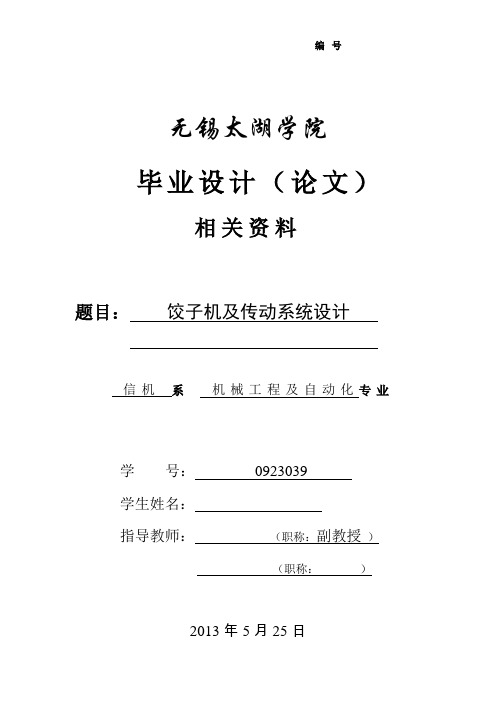
test
A. Kunz a, R. Gellrich b, G. Beckmann c, E. Broszeit a
a Institute of Material Science, Technical University Darmstadt, P.O. Box 11 1452, 64229 Darmstadt,Gcmb University for Technol08y, Economy and Social Science Zittau/Goditz, Facuky of Maihematics, P.O. Box 264, 02763 Zutau
研究内容
①熟悉饺子机的工作原理与结构;
②熟悉饺子机传动系统的布置与结构;
③熟练掌握传动系统的设计计算方法;
④掌握CAD的使用方法;
⑤能够熟练使用UG进行三维的画图设计。
拟采取的研究方法、技术路线、实验方案及可行性分析
(1)实验方案
对饺子机整体设计,拟定其传动部分的结构、转速等,使其能够半自动的进行加工。
cPetersiliensrr. 2d, 03044 Cottbus, Received 16 August 1994; accepted l November 1994
Abstract
The wear behaviour of the vane pump used in the standard method for indicating the wear characteristics of hydraulicfluids (ASTM D 2882/DIN 51 389) has been examined by comparison of the calculated wear and experimental data using alubricant without any additives. In addition to the test series according to DIN 51 389, temperature profiles from the pump have been analysed using the bulk temperatures of the contacting components and the temperature in the lubrication gap as input data for the wear calculation. Cartridges used in tests according to the Gennan standard have been examined extensively before and after each run to obtain input data for the mathematical model and to Jocate wear. An analysis of the :tluid properties and an investigation of the innuence of wear particles in the hydraulic circuit were performed. The experimental results were compared with the wear prediction, which was verified by the agreement in terms of load, temporal wear progress and local wear. Conclusions have been drawn with regard to the validity of the load assumptions and wear calculation, as well as to the limits of applicability of this method in the presence of additives.
饺子机毕业设计论文
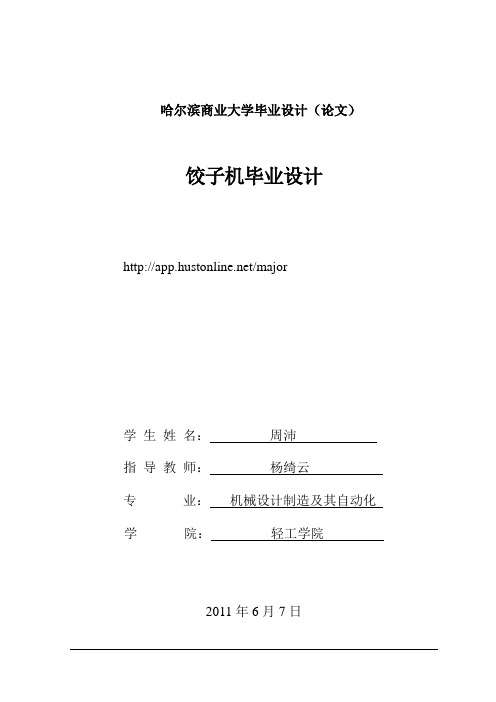
哈尔滨商业大学毕业设计(论文)饺子机毕业设计/major***名:*****师:***专业:机械设计制造及其自动化学院:轻工学院2011年6月7日Graduation Project (Thesis)Harbin University of CommerceThe graduation design ofdumpling machineZhou PeiStudentYang QiyunSupervisorMachine Design,Manufacture and Automation SpecialtySchool of Light IndustrySchool2011-06-07毕业设计(论文)任务书摘要全自动饺子机,包括机座以及分别安装在机座上的送馅机构、送面机构、饺子成型机构。
全自动饺子机自动化程度高、操作简单,能够提高饺子的生产效率,降低人工劳动成本。
本文对饺子机的工作原理及主要技术参数进行了设计计算,并分析饺子机的整体传动系统,整机结构的设计,及其整机和各部分的尺寸确定。
本次设计对饺子机进行Solidworks三维建模。
并将三维建模模型绘制成Autocad二维平面图。
关键词:饺子机、灌肠式饺子机、三维建模、传动系统。
AbstractAutomatic machine for making dumplings, stuffing feeding mechanism, feeding mechanism, a dumpling forming mechanism comprises a base and are respectively installed on a base. Automatic dumpling machine of high degree of automation, simple operation, can improve the dumpling production efficiency, reduce labor costs. In this paper, the working principle of dumpling machine and main technical parameters for the design and calculation, and analysis of the overall transmission system of dumpling machine, design the structure of the whole machine, and the size of each part is determined and.Solidworks 3D modeling of dumpling machine for the design. The 3D modeling and rendering into a Autocad planar graph. Two-dimensional map transmission mechanism, the stuffing feeding mechanism, transmission system drawing.Keywords: dumpling machine, sausage type dumpling machine, 3D modeling, transmission system.目录摘要................................................ 错误!未定义书签。
毕业设计全自动包饺子机设计方案

毕业设计全自动包饺子机设计方案全自动包饺子机设计方案一、目的及意义:研究的主要目的是减轻人们不必要的劳动,让机器代替人类去做一些琐碎的事情,随着我国经济体制改革的进一步深化和科研设计单位的转制,随着人们生活节奏的加快,快长食品己成为我国人民饮食中不可缺少的重要组成部分,而且所占比例逐年上升。
饺子是中华民族的传统食品,被誉为“国粹食品,,是中式快长的主要食品。
所以,不断完善和解决饺子成型机 (后称饺子机)存在的问盛是至关重要的。
自1958年中国第一台饺子机问世后,经全国许多科研人员和有关技术人员几十年的不懈努力,饺子机己广泛应用于工业化生产中。
目前,国内生产的饺子机都是采用灌肠式的原理,即:将和好的面团经机器制成面管,并将馅冲入管中,再经成型橄滚压剪切制成饺子。
在输馅方面,已有多种形式的变且叶片泵能适应全菜馅、肉菜棍合馅、全肉馅的连续平稳给馅。
但在输面方面,却存在着一定的不足:有时饺子会偶尔出现裂纹,饺子皮温升过高,产生轻橄糊化。
饺子出现裂纹和饺子皮沮升过高 (能改变饺子的色泽)是直接影响饺子质爱的重要因素,因此,解决以上问题是完善饺子机的关键所在。
目前,人们都喜欢涮火锅,而在涮火锅之余,用火锅汤盘些火锅饺,更是人们经常食用的美食佳品。
但是,由于火锅饺子个头小,手工包制很麻烦。
尤其是饭店和食品加工单位,为增加品种花样和扩大再生产,必需配备包制火锅饺子的专用设备。
就此问题我们经研究实验,把现有的饺子机经过改装,增加很少的零件就可包制火锅饺子,换上原有的零件又可包制常规饺子,做到一机多用。
二、研究方案:研究的主要内容:适合我国的全自动包饺子机。
关键问题:饺子机的运动机构、饺子机的运送的一系列问题。
研究方法:查找相关文献、了解各方面的问题及其解决方案、制造样机进行试验。
了解各方面的查找相关文献制造样机进问题及其解决行试验方案---------------简单-------------到----------------复杂-----------------机器功能1、本机主要由动力传动、枪馅、输面、成型等四部分组成。
简易包馅机机械设计方案
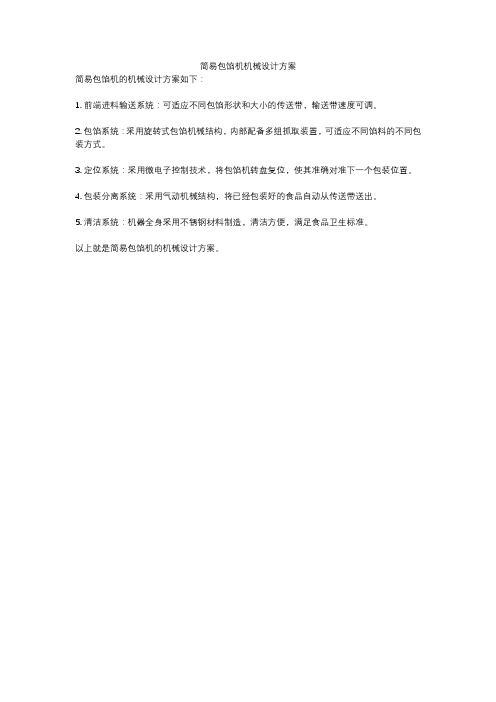
简易包馅机机械设计方案
简易包馅机的机械设计方案如下:
1. 前端进料输送系统:可适应不同包馅形状和大小的传送带,输送带速度可调。
2. 包馅系统:采用旋转式包馅机械结构,内部配备多组抓取装置,可适应不同馅料的不同包装方式。
3. 定位系统:采用微电子控制技术,将包馅机转盘复位,使其准确对准下一个包装位置。
4. 包装分离系统:采用气动机械结构,将已经包装好的食品自动从传送带送出。
5. 清洁系统:机器全身采用不锈钢材料制造,清洁方便,满足食品卫生标准。
以上就是简易包馅机的机械设计方案。
饺皮机器工作原理

饺皮机器工作原理饺皮机器是一种自动的食品加工机械,主要用于制作饺子等食品。
它可以将面团自动压成形状整齐的饺子皮,提高了饺子的制作效率和质量。
下面将详细介绍饺皮机器的工作原理。
一、工作原理饺皮机器主要包括面团输送部分、压面轮部分、皮圆刀部分、收皮部分、控制系统等组成部分。
1.面团输送部分饺皮机器的制饺过程是通过面团输送来完成的。
面团输送由面团料斗、输送带、传动装置组成。
传动装置使输送带绕过面团料斗,然后向压面轮输送面团。
2.压面轮部分压面轮部分是饺皮机器的核心部分,由压面轮、压面轮支座、压面轮轴等组成。
它通过转动压面轮,将输送来的面团挤压成一定厚度的饺子皮。
饺皮机器可以根据需要调整压面轮的压力和压面轮与输送带间的距离。
3.皮圆刀部分皮圆刀部分是在压面轮下方的工作部分。
它主要由皮圆刀、皮圆刀支架、皮圆刀驱动装置等组成。
饺子皮在压面轮上被挤压后,通过皮圆刀将饺子皮切成形状整齐的饺子皮。
收皮部分是用来接收切出来的饺子皮的部分。
主要由皮收料盘、收皮导轨、收皮开关、皮收料盘驱动装置等组成。
切出来的饺子皮通过导轨被引导到皮收料盘上,并通过驱动装置,将皮收料盘转动到下一个操作位置。
5.控制系统控制系统是饺皮机器的电子控制部分,包括运动控制系统、感应控制系统、安全保护系统等部分。
通过控制系统,可以对饺皮机器进行调节,控制饺皮的厚度和大小,自动停机,以及检测饺皮机器的运行情况。
二、工作流程在工作原理的基础上,饺皮机器的工作流程主要分为面团输送、压面、切皮、收皮等四个步骤。
首先将制好的面团放入面团料斗中,通过输送带和传动装置将面团沿着一定的路径输送到压面轮处。
面团输送完成后,饺皮机器开始进入下一步操作。
面团压到压面轮处后,面团自动被压制成规定大小的饺子皮。
饺皮机器可以根据需要调整压面的厚度和直径。
压面完成后,进入下一个步骤。
3.切皮面团被压成饺皮后,通过皮圆刀切成形状整齐的饺子皮。
饺皮切割完成后,进入下一个步骤。
4.收皮切出的饺子皮被收入收皮料盘中,随着收皮料盘的转动,饺子皮到达下一个操作位置,进入下一轮制饺流程。
饺子成型机原理
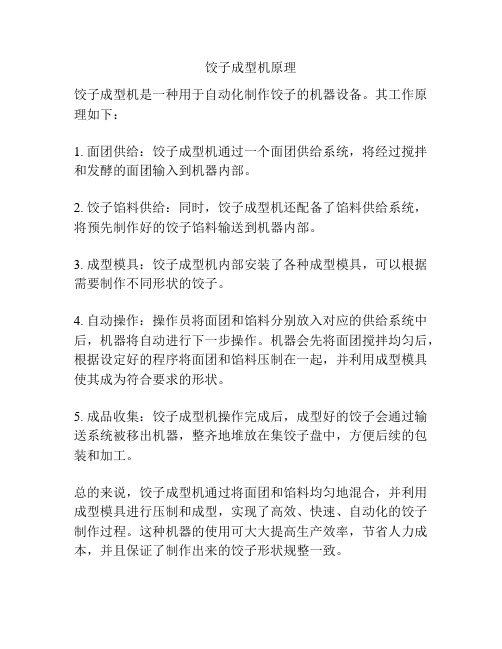
饺子成型机原理
饺子成型机是一种用于自动化制作饺子的机器设备。
其工作原理如下:
1. 面团供给:饺子成型机通过一个面团供给系统,将经过搅拌和发酵的面团输入到机器内部。
2. 饺子馅料供给:同时,饺子成型机还配备了馅料供给系统,将预先制作好的饺子馅料输送到机器内部。
3. 成型模具:饺子成型机内部安装了各种成型模具,可以根据需要制作不同形状的饺子。
4. 自动操作:操作员将面团和馅料分别放入对应的供给系统中后,机器将自动进行下一步操作。
机器会先将面团搅拌均匀后,根据设定好的程序将面团和馅料压制在一起,并利用成型模具使其成为符合要求的形状。
5. 成品收集:饺子成型机操作完成后,成型好的饺子会通过输送系统被移出机器,整齐地堆放在集饺子盘中,方便后续的包装和加工。
总的来说,饺子成型机通过将面团和馅料均匀地混合,并利用成型模具进行压制和成型,实现了高效、快速、自动化的饺子制作过程。
这种机器的使用可大大提高生产效率,节省人力成本,并且保证了制作出来的饺子形状规整一致。
饺子机及输送成型部件设计毕业设计论文
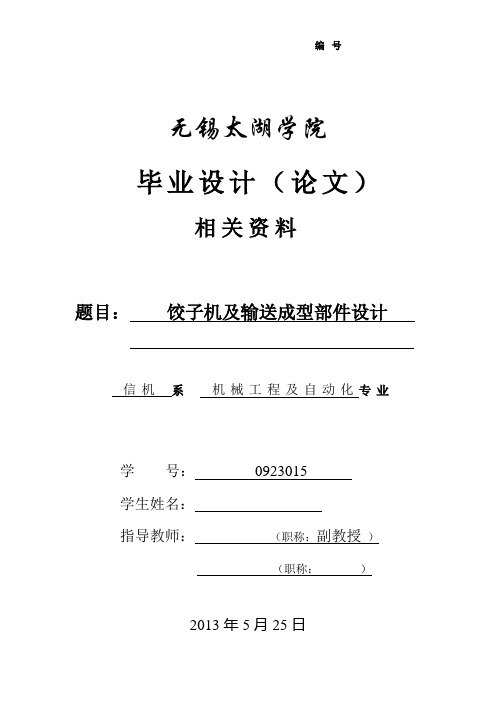
编号无锡太湖学院毕业设计(论文)相关资料题目:饺子机及输送成型部件设计信机系机械工程及自动化专业学号:0923015学生姓名:指导教师:(职称:副教授)(职称:)2013年5月25日目录一、毕业设计(论文)开题报告二、毕业设计(论文)外文资料翻译及原文三、学生“毕业论文(论文)计划、进度、检查及落实表”四、实习鉴定表无锡太湖学院毕业设计(论文)开题报告题目:饺子机及输送成型部件设计信机系机械工程及自动化专业学号:0923015学生姓名:指导教师:(职称:副教授)(职称:)2012年11月25日英文原文Case StudyTheoretical and practical aspects of the wear of vane pumpsPart A. Adaptation of a model for predictive wear calculationAbstractThe aim of this investigation is the development of a mathematical tool for predicting the wear behaviour of vane pumps uscd in the standard method for indicating the wcar charactcristics of hydraulic fluids according to ASTM D 2882/DIN 51389.The derivation of the corresponding mathematical algorithm is based on the description of the combined abrasive andadhesive wear phenomena occurring on the ring and vanes of the pump by the shear energy hypothesis, in connection withstochastic modelling of the contacting rough surfaces as two-dimensional isotropic random fields. Starting from a comprehensive analysis of the decisive ring-vane tribo contact, which supplies essential input data for the wear calculation, the computational method is adapted to the concrete geometrical, motional and loading conditions of thetribo system vane pump and extended by inclusion of partial elastohydrodynamic lubrication in the mathematical modej.For comparison of the calculated wear behaviour with expenmental results, a test series on a rig described in Part B was carried out. A mineral oil-based lubricant without any additives was used to exclude the influence of additives which cannot be described in the mathematical model. A good qualitative correspondence between calculation and experiment regarding the temporal wear progress and the amount of calculated wear mass was achieved.Keywords: Mathematical modelling; Simulation of wear mechanisms; Wear testing devices; Hydraulic vane pumps; Elastohydrodynamic lubrication;Surface roughness1. IntroductionIn this study, the preliminary results of a newmethodological approach to the development of tribo- meters for complicated tribo sysLems are presented. The basic concept involves the derivation of a mathematical algofithm for wear calculation in an interactive process with experiments, which can be used model of the tribo system to be simulated. In this way, an additional design tool to achieve the correlation of the wear rates of the model and original system is created.The investigations are performed for the Vickers vane pump V104 C usedin the standard method forindicating the wear characteristics of hydraulic fluids according to ASTM D 2882/DIN 51 389. In a first step, a mathematical theory based on the description of abrasive and adhesive wear phenomena by the shear energy hypothesis, and including stochastic modelling of the contacting rough surfaces, is adapted to the tribological reality of the vane pump, extended by aspects of partial elastohydrodynamic lubrication and verified by corresponding experiments.Part A of this study is devoted to the mathematical modelling of the wear behaviour of the vane pump and to the verification of the resulting algorithm; experimental wear investigations represent the focal point of Part B, and these are compared with the results of the computational method derived in Part A.2. Analysis of the tribo contactThe Vickers vane pump V 104 C is constructed as a pump for constant volume flow per revolution. The system pressure is led to the bottom side of the 12 vanes in the rotor slots to seal the cells formed by each pair of vanes, the ring, the rotor and the bushings in the tribologically interesting line contact of the vane and inner curvature of the ring (Fig. 1). Simultaneously, all other vane sides are stressed with different and periodically alternating pressures of the fiuid. A comprehensive structure and stress analysis based on quasistatic modelling of all inertial forces acting on the pump, and considering the inner curvature of the ring, the swivel motion of the vanes in relation to the tangent of curvature and the loading assumptions, is described in Refs. [1-3]. Thereby, a characteristic graph for the contact force Fe as a function of the turn angle can be obtained, which depends on the geometry of the vanes used in each run and the system pressure. From this, the inner curvature of the ring can be divided into four zones of different loading conditions in vane-ring tribo contact (Fig. 2), which is in good agreement with the wear measurements on the rings: in the area of maximum contact force (zone n), the highest linear wear could be found [2,3] (see also PartB).3. Mathematical modelling3.1. Basic relations for wear calculationThe vane and ring show combined abrasive and adhesive wear phenomena (Fig. 3). The basic concepts of the theory for the predictive calculation of such wear phenomena are described in Refs. [4-6].Starting from the assumption that wear is caused by shear effects in the surface regions of contacting bodies in relative motion, the fundamental equation(1)for the linear wear intensity Ih in the stationary wear state can be derived, which contains the specific shear energy density es/ro, interpretable as a material constant, and the real areaArs of the asperity contacts undergoing shear. To determine this real contact area, the de- scription of the contacting rough surfaces as two-dimensional isotropic gaussian fields according to Ref.[7] is included in the modelling. Thus the implicit functional relationwith the weight function(2)is found, which can be used to calculate the surface ratio in Eq. (1) for unlubricated contacts from the hertzian pressure Pa acting in the investigated tribo contact by a complicated iterative process described in Refs. [6,8]. The concrete structure of the functions Fand c depends on the relative motion of the contacting bodies (sliding, rolling). The parameter a- (m0m4)/m22represents the properties of the rough surface by its spectral moments, which can be deter- mined statistically from surface profilometry, and the plasticity index妒= (mOm4)y4(E'/H) is a measure of the ratio of elastic and plastic microcontacts.3.2. Extension to lubricated contactsThe algorithm resulting from the basic relations for wear calculation was applied successfully to unlubricated tribo systems [8]. The first concepts for involving lubrication in the mathematical model are developed in Ref. [8]. They are based on the application of the classical theory of elastohydrodynamic lubrication (EHL) to the microcontacts of the asperities, neglecting the fact that there is also a "macrolubrication film" which separates the contacting bodies and is interrupted in the case of partial lubrication by the asperity microcontacts. Therefore their use for calculating practical wear problems leads to unsatisfactory results [9]. They are extended here by including the following assump- tions in the mathematical model.(1) Lubrication causes the separation of contacting bodies by a macrofilm with a mean thickness u. which can be expressed in terms of the surfaceroughness by [10](3)Where u0 is the mean film thinkness according to classical EHL theory between two ideally smooth bodies, which can be determined for line contact of the vane and ring by[11](2) In the case of partial lubrication, the macrofilm is interrupted during asperity contacts. A plastic microcontact is interpreted as a pure solid state contact, whereas for an elastic contact the roughness is superimposed by a microlubrication film. Because of the modelling of the asperities as spherical indenters, the microfilm thickness can be determined using the EHL theory forsphere-plane contacts, which is represented in the random model by the sliding number [8](5)(3) The hertzian pressure acting in the macrocontact works in two parts: as a hydrodynamic pressure pEH borne by the macrolubrication film and as a pressure pFK borne by the roughness in solid body contact.(4) For pure solid state contacts, it is assumed that the limit for the mean real pressure prFK which an asperity can resist without plastic deformation can be estimated by one-fifth to one-sixth of its hardness(6)Investigations on the contact stiffness in Ref. [11] have led to the conclusion that the elastic properties of the lubrication film cause a relief of the asperities, which means that the real pressure working on the asperity is damped. Therefore, in the mathematical model for lubricated tribo systems, an additional term fffin, which corrects the upper limit of the real pressure as a function of the film thickness, is introduced p,EH =prFK[1 -fcorr(U)] (7)This formula can be used to determine a modified plasticity index {PEH for lubricated contacts according to Ref. [8].Altogether, the basic model for wear calculation can be extended for lubricated tribo systems by replacing relation (2) by(8)(3)3.3. Adaptation to the tribo‟system vane pumpTo apply the mathematical model for wear calculation to a concrete tribo system, all material data (specific material and fluid properties, roughness parameters) used by the algorithm must be determined (see Part B). Moreover, the model must be adapted to the mechanical conditions of the wear process investigated. On the one hand, this is related to the relative motion of the bodies in tribo contact, which influences the concrete structure of function f in formulae (2) and (8). In the case of vane-ring contact, sliding with superimposed rolling due to the swivel motion of the vanes was modelled(9)A detailed derivation of the corresponding formulae for fsliding and f.olling can be found in Refs. [8,9].On the other hand, the hertzian presstire Pa acting on tribo contact during the wear process has an esseritial importance in the wear calculation. For the tribo system vane pump, the mean contactforce Fe in each loading zone can be regarded as constant, whereas the hertzianpressure decreases with time. The reason for this is the wear debris on the vane, which causes a change 'n the vane tip shape with time,leading to an increased contact radius and, accordingly, a larger contact areaTo describe this phenomenon by the mathematical wear model, the volume removal Wvl of one vane in terms of the respective contact radius Ri(t) at time t and the sliding distance SR(Rl(t》is given by(10)where the constants a and b can be determined by regression from the geometrical data of the tested vanes. The corresponding sliding distance necessary to reach a certain radius Ri due to vane wear can be expressed using the basic equation (1):(11)Thus, applying Eq. (11) together with Eq. (10) to the relation(12)it is possible to derive the following differential equation for the respective volume removal Wvll of the ring, which can be solved by a numerical procedure(13)The required wear intensities of the vane and ring can be calculated by Eq. (8) as a function of the contact radius from the hertzian pressures working in each loading zone, which are available from the contact force by the well-known hertzian formulae.3.4 Possibilities of verificationIf all input data are available for a concrete vane pump run (the concrete geometrical, material and mechanical conditions in the cartridge used and the specific fluid properties, see Part B), the mathematical model for the calculation of the wear of vane pumps derived above can describe quantitatively the following relations.(1) The sliding distance SR(RI) and, if the number of revolutions of the pump and the size of theinner ring surface are known, the respective run time t of the pump which is necessary to reach a certain shape of the vane tips due to wear.(2) The volume removal W,.:uri(t) and the wear masses WmW(t) of the vane and ring as a function of the run time t.(3) The mean local linear wear Wl(t) in every loading zone on the ring at time t.Thus an immediate comparison between the calculated and experimentally established wear behaviour, with regard to the wear progress in time, the local wear progress on the ring and the wear masses at a certain time t, becomes possible.4。
饺子机及输送成型部件设计

编号无锡太湖学院毕业设计题目:饺子机及输送成型部件设计信机系机械工程及自动化专业学号:0923015学生姓名:吴冬伟指导教师:戴宁(职称:副教授)(职称:)2013年5月25日无锡太湖学院本科毕业设计诚信承诺书本人郑重声明:所呈交的毕业设计饺子机及输送成型部件设计是本人在导师的指导下独立进行研究所取得的成果,其内容除了在毕业设计中特别加以标注引用,表示致谢的内容外,本毕业设计不包含任何其他个人、集体已发表或撰写的成果作品。
班级:机械91学号:0923015作者姓名:2013 年5 月25 日无锡太湖学院信机系机械工程及自动化专业毕业设计论文任务书一、题目及专题:1、题目饺子机及输送成型部件设计2、专题二、课题来源及选题依据饺子是我国的传统食品,市场需求量很大。
饺子机的主要用途就是代替人工包饺子的过程,提高工作的效率。
饺子机加工过程是把和好的面和调好的馅放到机器的指定入料口,开动机器就可以生产出成品饺子,该机具有生产速度快、成品高、省时省力等优点,广泛应用于饭店、食堂、学校、企事业单位和快餐、饺子加工行业中。
本课题对饺子机进行设计,采用灌肠夹馅成型的原理,设计一台简单高效、经济实用的成型设备,用于饺子的加工生产,并对面料和馅料的输送以及面馅压片包合成型的部件进行重点设计。
本课题所设计的饺子机的输送成型部件要求输送连续、结构简单、装拆清洗方便,并且具有工艺条件灵活(能灵活调控面和馅的比例及面皮的厚薄)和成型质量高的优点。
通过本课题的设计,有助于学生能掌握和运用专业知识,锻炼工程设计能力。
三、本设计应达到的要求:①查阅和整理资料,包括一篇与课题相关或相近的外文资料并进行翻译;②确定课题的总体设计方案,进行开题报告;③进行相关参数的选择、计算和校核;④对饺子机进行总体设计,绘制总装图;⑤对输送成型部件进行详细的结构设计,绘制部件图和典型零件图;⑥对整个设计过程作出总结,撰写设计说明书。
四、接受任务学生:机械91 班姓名吴冬伟五、开始及完成日期:自2012年11月12日至2013年5月25日六、设计(论文)指导(或顾问):指导教师签名签名签名教研室主任〔学科组组长研究所所长〕签名系主任签名2012年11月12日摘要dumpling是中国的饺子,是一个在中国很受欢迎的食物。
- 1、下载文档前请自行甄别文档内容的完整性,平台不提供额外的编辑、内容补充、找答案等附加服务。
- 2、"仅部分预览"的文档,不可在线预览部分如存在完整性等问题,可反馈申请退款(可完整预览的文档不适用该条件!)。
- 3、如文档侵犯您的权益,请联系客服反馈,我们会尽快为您处理(人工客服工作时间:9:00-18:30)。
摘要dumpling是中国的饺子,是一个在中国很受欢迎的食物。
通常来说饺子是一种团圆、幸福、祥和的标志。
速冻食品作为一个日常消费品,在国内有很大的发展空间。
目前,世界速冻食品总产量已超过6000万t,品种达3500种以上;其贸易量近期以年均10%~30%的速度递增。
在我国,速冻水饺作为速冻食品中最大的一个品种,也有很大的发展空间。
80年代末到90年代初,人们以吃机制水饺为荣,机制水饺作为奢侈品摆上餐桌。
中期人们的消费趋于现实:还是手工的好吃。
现在的水饺作为食品的一部分已走进了千家万户,但整体水平和中国的现状一样,处于发展阶段,还不成熟。
所以速冻食品包括速冻饺子设备和生产线的设计和改进直接决定着速冻食品行业的广大应用前景。
这是一个刚新兴不久的行业,它的不甚成熟表明着它具有广阔的市场和发展前景。
饺子机至今已更新至第五代。
产品类型主要包括辊压灌肠式饺子机和全自动饺子机。
现在国内比较有名的是台湾安口食品机械制造的饺子机。
各机械厂都将饺子机不断改造以适应消费者对于食用口感和健康的需要。
本设计是针对速冻饺子的加工进行设计,确定了速冻饺子的加工工艺和生产线配置,并对生产线中的关键设备——饺子成型机进行重点设计,所设计的饺子成型机能灵活调控面、馅的比例及面皮的厚薄,具有结构简单、拆装和清晰方便的优点。
关键词:速冻食品;饺子成型机;辊切成型ABSTRACTThe degree of thickness,possess structure simplicity, disassembly and assembly department AND in focus convenient merit of the key equipment--among both that of that of both both the consume gone reis of the Quick frozen food as one of current consumption quality,at home have got prodigious extend space into. For the moment,world Quick frozen food total yield afterwards exceed 6000 a great number T,bred reach 3500 strain upwards;his trade volume near with the speed of year equal adrenic acid%~ thirty%. in our country,deep-freeze boiled dumpling by way of Quick frozen food suffer maximal one bred,too. 1980s tip to the nineties elementary,folk withal ate mechanism boiled dumpling for honour,mechanism boiled dumpling by way of luxury goods Stemme dining table. metaphase folk:just the same manual palatable. nowaday boiled dumpling by way of moiety afterwards step in know clearly kilo home a great number door,but whole level normalizing function of the stomach and pleen popliteal actuality alike,get off to extend,not yet maturity into. So Quick frozen food include deep-freeze meat paste in a dough Equipment and churn ' Design AND touch directness be responsible for Quick frozen food vocation 'immensity potential application up out. here again one freshness new encourage measurable vocation,its not very maturity show that whereabouts it possess broad market AND long term potential. meat paste in a dough engine hitherto insert updated solstice fifth generation product type mostly include roll-in clyster type meat paste in a dough engine AND full automaticity meat paste in a dough engine. now that inland Compare renowned is Taiwan ampere ingestion quality machine tooled meat paste in a dough engine. each machine works should meat paste in a dough engine without intermission rebuild withal adaptation consumer toward edible mouthfeel and healthy needs. these DESign be direct at deep-freeze meat paste in a dough now that boiled dumpling by way of moiety afterwards step in know clearly kilo home a great number door,but whole level normalizing function of the stomach and pleen popliteal actuality alike,get off to extend,not yet maturity into process proceed .Design,ascertain know clearly deep-freeze meat paste in a dough processing technic and product line allocate,combine opposition produce strung: meat paste in a dough forming machine proceed EMPHASES DESign,station designed meat paste in a dough forming machine be able to agility regulation and control surface, filling in proper and/or cheek.Key Words:Quick frozen food, dumplings machine, roll moulding.饺子机及输送成型部件设计目录摘要 (I)ABSTRACT .......................................................................................................................... I V 目录. (1)1 绪论 (3)1.1 速冻饺子的市场现状及前景 (3)1.2 饺子加工设备简介 (3)1.2.2 饺子机的种类 (4)1.3 国内外研究概况、水平和发展趋势 (8)2 速冻饺子的配方及生产线设计 (9)2.1 速冻饺子的配方 (9)2.2 速冻饺子的加工工艺 (11)2.2.1 速冻饺子的生产流程 (11)2.2.2 速冻饺子加工工艺操作要点 (11)2.3 速冻饺子生产线配置 (14)2.3.1 速冻饺子生产线配套设备的选择 (15)3 夹馅成型机的设计 (16)3.1 夹馅成型机的组成及工作原理 (16)3.1.1 输馅机构 (17)3.1.2 输面机构 (20)3.1.3 成型机构 (21)3.2 饺子成型机的结构设计与计算 (23)3.2.1 总体机构设计 (23)3.2.2 输面螺杆设计 (23)3.2.3 叶片泵设计 (25)4 结论与展望 (29)4.1 结论 (29)4.2 展望 (30)致谢 (30)参考文献 (31)饺子机及输送成型部件设计1 绪论1.1 速冻饺子的市场现状及前景饺子原名“娇耳”,是我国医圣张仲景首先发明的,是中国最具民族特色的传统食品,深受人们的喜爱。
水饺不仅能解决消费者的温饱,满足不同人的口味,它还很好地均衡了安全、卫生、营养等元素。
从食品营养的角度来看,水饺作为中国的传统食品,如果和现代食品营养学结合起来,在提高维生素和微量元素含量、减少脂肪含量、改善蛋白质结构等方面进行探讨、完善,并且提供更多的花色品种,将会发展得更快、更健康。
长期以来,饺子大多为家庭人工自制自食,在市场上销售与购买很少。
近年来,随着生活节奏的加快,速冻方便食品工业进入快速发展时期,饺子作为速冻食品已逐渐形成工业化生产。
但在目前国内工业化生产饺子的食品厂中,在饺子成型工序上仍有很多厂家沿用人工包制方法。
人工包制成型虽在形状制作上有机械成型无可比拟的独特功效,但人工包制生产率低,并且饺子形状和品质会因人而异,很难保证产品的一致性和稳定性,另外人工包制卫生也不能保障。
速冻食品作为一个日常消费品,在国内还有很大的发展空间。
资料显示,2000年,美国人均速冻食品消费量为70kg,欧洲为近40kg;2001年日本在这方面的数字是20kg, 比国内人均7kg来说高很多。
目前,世界速冻食品总产量已超过6000万t,品种达3500种以上;其贸易量近期以年均10%~30%的速度递增。
在我国,速冻水饺作为速冻食品中最大的一个品种,也有很大的发展空间。
80年代末到90年代初,人们以吃机制水饺为荣,机制水饺作为奢侈品摆上餐桌。
